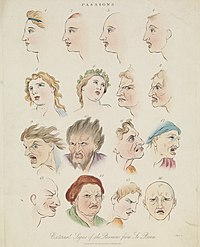
Anger, sad, and blended expressions to contingency disruption in young infants
Sign Up to like & getrecommendations! Published in 2018 at "Developmental Psychobiology"
DOI: 10.1002/dev.21768
Abstract: Three studies elicited young infants' (aged 17-23 weeks) anger and sad facial expressions during brief contingency disruptions to explore their potential organization over time as a biphasic process. Study 1 examined partial correlations among anger, sad,… read more here.
Keywords: anger sad; disruption; sad blended; contingency ... See more keywords

Obstructive sleep apnea in young infants: Sleep position dependence and spontaneous improvement
Sign Up to like & getrecommendations! Published in 2022 at "Pediatric Pulmonology"
DOI: 10.1002/ppul.26255
Abstract: The natural evolution of obstructive sleep apnea (OSA) in young infants is not established. read more here.
Keywords: sleep apnea; obstructive sleep; apnea young; young infants ... See more keywords

Clostridium difficile infections in young infants: Case presentations and literature review
Sign Up to like & getrecommendations! Published in 2017 at "IDCases"
DOI: 10.1016/j.idcr.2017.07.005
Abstract: It has been assumed that symptomatic Clostridium difficile infections do not occur in young infants, as this specific group would lack specific C. difficile toxin receptors. As a consequence, it is often current practice not… read more here.
Keywords: clostridium difficile; difficile infections; difficile; case ... See more keywords

Population pharmacokinetics and dosing optimization of latamoxef in neonates and young infants.
Sign Up to like & getrecommendations! Published in 2019 at "International journal of antimicrobial agents"
DOI: 10.1016/j.ijantimicag.2018.11.017
Abstract: OBJECTIVES There has been recent renewed interest in historical antibiotics because of the increased antibiotic-resistant bacterial strains. Latamoxef, a semi-synthetic oxacephem antibiotic developed in 1980s, has recently been brought back into use for treatment of… read more here.
Keywords: latamoxef neonates; latamoxef; neonates young; young infants ... See more keywords

Young infants' visual fixation patterns in addition and subtraction tasks support an object tracking account.
Sign Up to like & getrecommendations! Published in 2017 at "Journal of experimental child psychology"
DOI: 10.1016/j.jecp.2017.05.007
Abstract: Investigating infants' numerical ability is crucial to identifying the developmental origins of numeracy. Wynn (1992) claimed that 5-month-old infants understand addition and subtraction as indicated by longer looking at outcomes that violate numerical operations (i.e.,… read more here.
Keywords: object tracking; addition subtraction; young infants; tracking account ... See more keywords

Viral bronchiolitis in young infants: new perspectives for management and treatment.
Sign Up to like & getrecommendations! Published in 2017 at "Jornal de pediatria"
DOI: 10.1016/j.jped.2017.07.003
Abstract: OBJECTIVE The aim of this review was to address advances in management and treatment of acute viral bronchiolitis in infants. SOURCES A systematic review search was made including all articles published in English between 2010… read more here.
Keywords: bronchiolitis; viral bronchiolitis; bronchiolitis young; management ... See more keywords

The shape of disposable diaper affects spontaneous movements of lower limbs in young infants
Sign Up to like & getrecommendations! Published in 2019 at "Scientific Reports"
DOI: 10.1038/s41598-019-52471-4
Abstract: This study examined the characteristics of young infants’ lower limb spontaneous movements based on differences in shape of diapers. Twenty-seven healthy infants (103 ± 16.3 days old) were enrolled in this study. We measured the spontaneous movements… read more here.
Keywords: movements lower; spontaneous movements; young infants; lower limbs ... See more keywords

Ceftolozane/Tazobactam in Neonates and Young Infants: The Challenges of Collecting Pharmacokinetics and Safety Data in This Vulnerable Patient Population.
Sign Up to like & getrecommendations! Published in 2020 at "American journal of perinatology"
DOI: 10.1055/s-0039-3402719
Abstract: OBJECTIVE New treatments are needed for multidrug-resistant (MDR) gram-negative infections in neonates. Ceftolozane/tazobactam is a β-lactam/β-lactamase inhibitor combination that has broad-spectrum activity against most common gram-negative bacteria, including MDR strains. We evaluated pharmacokinetics (PK) and… read more here.
Keywords: ceftolozane tazobactam; safety; neonates young; young infants ... See more keywords

Ambulatory Treatment of Fast Breathing in Young Infants Aged
Sign Up to like & getrecommendations! Published in 2017 at "Clinical Infectious Diseases"
DOI: 10.1093/cid/ciw690
Abstract: (See the Editorial Commentary by Jehan and Qazi on pages 190–1.) Background. Integrated Management of Childhood Illness recommends that young infants with isolated fast breathing be referred to a hospital for antibiotic treatment, which is… read more here.
Keywords: arm; trial; treatment; young infants ... See more keywords

Severe Parechovirus 3 Infections in Young Infants—Kansas and Missouri, 2014
Sign Up to like & getrecommendations! Published in 2018 at "Journal of the Pediatric Infectious Diseases Society"
DOI: 10.1093/jpids/pix010
Abstract: Background Infection with parechovirus type 3 (PeV3) can cause severe neurologic and sepsis-like illness in young infants; clinical and epidemiologic descriptions have been limited. We aimed to characterize PeV3 illness and explore risk factors for… read more here.
Keywords: intensive care; pev3; young infants; illness ... See more keywords

Asymptomatic Adults and Children Can Transmit Human Parechoviruses and Enteroviruses to Neonates and Young Infants
Sign Up to like & getrecommendations! Published in 2017 at "Open Forum Infectious Diseases"
DOI: 10.1093/ofid/ofx163.1170
Abstract: Abstract Background Human parechovirus (HPeV) type 3 and enteroviruses (EVs) are the common viruses causing severe diseases in neonates and young infants. Given no specific therapy is currently available and the morbidity and mortality of… read more here.
Keywords: stool samples; family members; hpevs evs; neonates young ... See more keywords